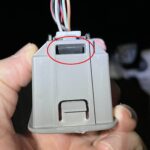When considering a 1996 Geo Metro, a common question arises: Is it equipped with OBD1 or OBD2? Understanding the diagnostic system in your vehicle is crucial for maintenance, repairs, and emissions testing. Let’s delve into whether a 1996 Geo Metro is OBD1 or OBD2 and what implications this has for owners.
OBD1 vs. OBD2: Key Differences for the Geo Metro
The transition from OBD1 to OBD2 was a significant shift in automotive diagnostics. OBD2 systems, mandated in the USA for most cars starting from 1996, offer a standardized approach to vehicle diagnostics, providing more data and easier access compared to their OBD1 predecessors. While the weight of the vehicle remains consistent regardless of the OBD system, the diagnostic capabilities differ significantly.
For a 1996 Geo Metro, you’ll likely find it equipped with OBD2. The OBD2 system offers several advantages:
- Enhanced Diagnostic Information: OBD2 systems provide a wider range of diagnostic trouble codes (DTCs) and live data parameters. This wealth of information can be invaluable for pinpointing issues and performing effective repairs.
- Standardized Connector: OBD2 utilizes a standardized 16-pin Diagnostic Link Connector (DLC), making it universally compatible with a wide array of scan tools and code readers.
- Easier Emissions Testing: In many regions, OBD2 simplifies emissions testing. A simple scan of the OBD2 port can quickly determine if the vehicle’s computer is reporting any emissions-related faults. If there are no active codes and the Malfunction Indicator Light (MIL), often called the “check engine light,” is off, the vehicle often passes the test. This is a contrast to older OBD1 systems that might require more complex testing procedures, such as exhaust sniff tests.
1996 Geo Metro OBD Considerations: Practical Implications
While there might not be a significant difference in fuel economy between a ’95 and ’96 Geo Metro related to the OBD system itself, the accessibility of diagnostic information is a key differentiator.
- Accessing Diagnostic Data: OBD2 systems are designed for easier data retrieval. While OBD1 systems often required specific tools and procedures, OBD2 systems are accessible with readily available and affordable OBD2 scan tools. Investing in a relatively inexpensive OBD2 scanner or program for your laptop can empower you to diagnose basic issues yourself, potentially saving on diagnostic fees at a repair shop.
- Aftermarket Parts and OBD2 Sensitivity: It’s worth noting that OBD2 systems can sometimes be more sensitive to aftermarket modifications, particularly those affecting the exhaust or emissions systems. For instance, issues can arise after exhaust replacements if oxygen sensor bungs are not positioned precisely, potentially triggering fault codes.
Engine Choice: A More Critical Factor
While the OBD system is important for diagnostics, when considering a Geo Metro, especially a four-cylinder model, the engine type is a more critical factor for overall performance and driving experience. The advice to prioritize the body condition and ignore the year to some extent holds merit. However, for four-cylinder Metros, it’s generally recommended to seek out models with the 16-valve engine, which were introduced in later years, as these offer improved performance compared to the earlier 8-valve engines found in 1995-1997 models.
Conclusion: OBD2 and Beyond for Your ’96 Geo Metro
In summary, a 1996 Geo Metro is highly likely to be equipped with an OBD2 system, offering enhanced diagnostic capabilities and simplified emissions testing in many areas. While the OBD system is a factor to consider, for a vehicle like the Geo Metro, focusing on finding a model with a well-maintained body and, if it’s a four-cylinder, the desirable 16-valve engine, should be a priority. The OBD2 system will provide you with valuable diagnostic information, making maintenance and potential repairs more manageable in the long run.

